Why Isn't My AC Working? A Snohomish Homeowner's Troubleshooting Guide
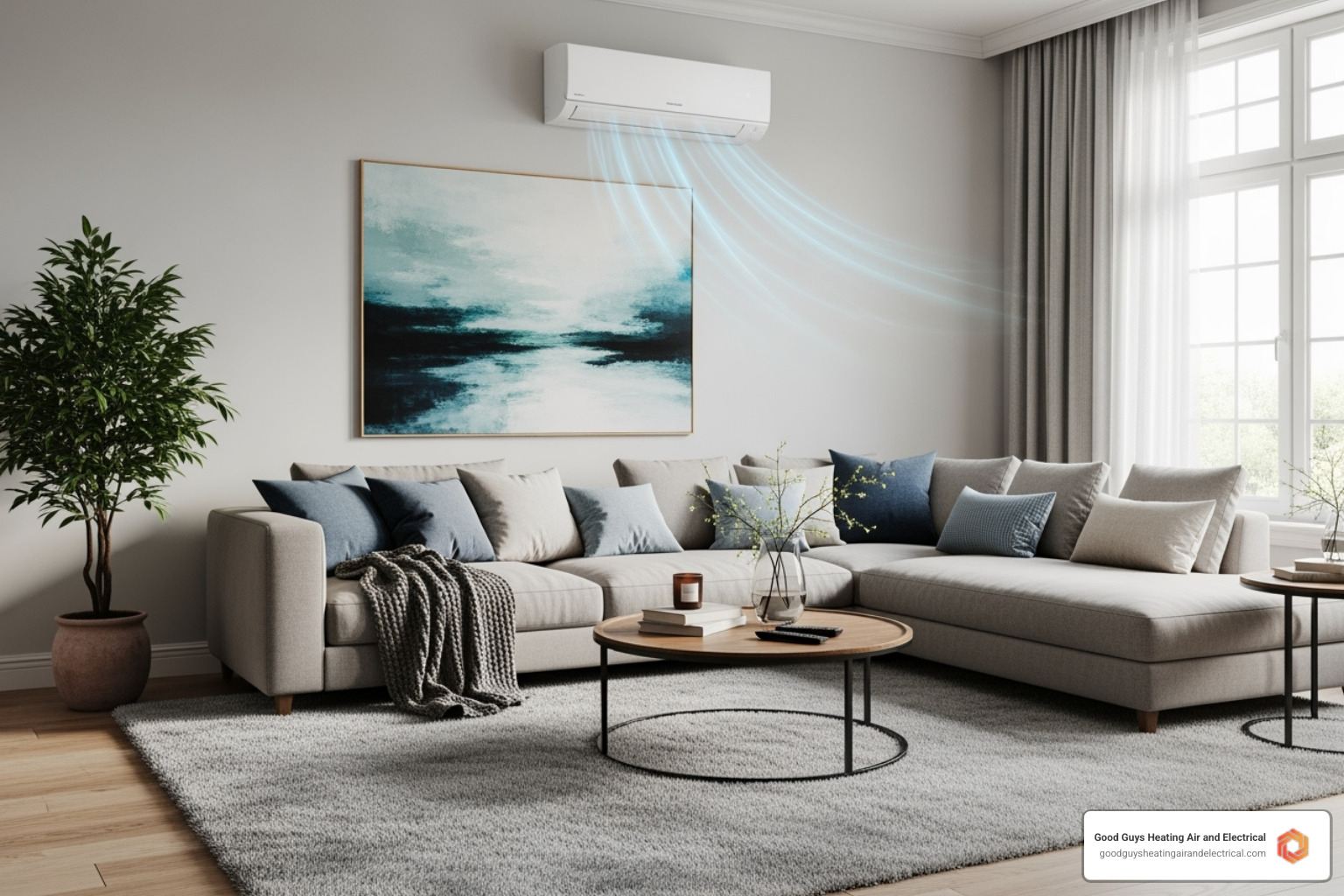
Why Your AC Might Stop Working in Snohomish, WA
When ac troubleshooting snohomish wa becomes your urgent search on a warm summer day, you need answers fast. An AC breakdown is frustrating, but the good news is that many common issues have simple solutions you can handle yourself.
Quick AC Troubleshooting Checklist:
- Check your thermostat - Is it set to COOL and a temperature below the current room temp?
- Inspect your air filter - A clogged filter is the #1 cause of AC problems.
- Verify power - Look for tripped breakers or blown fuses.
- Clear the outdoor unit - Remove any surrounding debris, leaves, and obstructions.
This guide walks you through the most common AC problems we see in Snohomish County homes. You'll learn which fixes are safe to try yourself and when it's time to call the experts at Good Guys Heating, Air & Electrical. We'll cover simple DIY checks, warning signs that require a pro, and how to decide between repair and replacement.
Whether you're in Lake Stevens, Everett, Marysville, or Monroe, understanding your AC system helps you make smart decisions about repairs and maintenance.
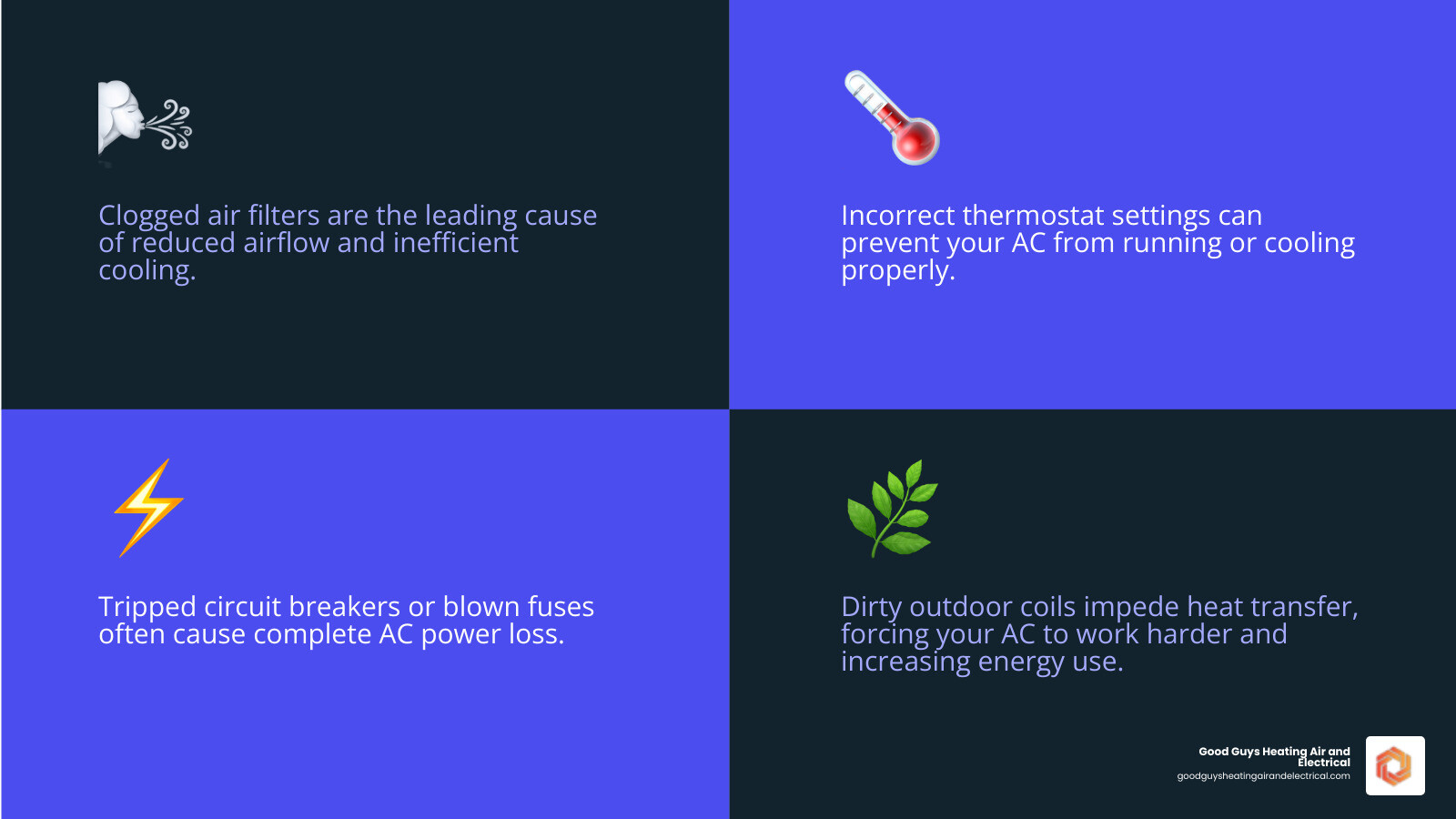
DIY Fixes: Simple AC Troubleshooting for Snohomish, WA Homeowners
Before scheduling a service call, walk through these simple checks. Many common AC problems can be solved in just a few minutes, saving you time and the wait for a technician. These steps are safe for homeowners and are your first line of defense when your AC acts up.
Step 1: Check Your Thermostat
An incorrect thermostat setting is a frequent cause of cooling issues. Start by confirming your thermostat is set to COOL mode, not HEAT, OFF, or FAN ONLY. Next, ensure the temperature setting is lower than the current room temperature; otherwise, your system has no reason to turn on. Drop it a few degrees and wait a minute.
Also, set the fan to AUTO. On AUTO, the fan only runs during a cooling cycle. If it's set to ON, the fan circulates air constantly, which can make you think the AC is working when it's just moving warm air.
Dead batteries can disable a digital thermostat without warning. Pop in fresh batteries to see if that restores power. For smart thermostats, a simple reboot can often fix glitches. Turn off its power at the circuit breaker for a minute, then turn it back on.
Need more detailed help? Our Emergency AC Troubleshooting Guide for Homes walks you through additional steps.
Step 2: Inspect Your Air Filter
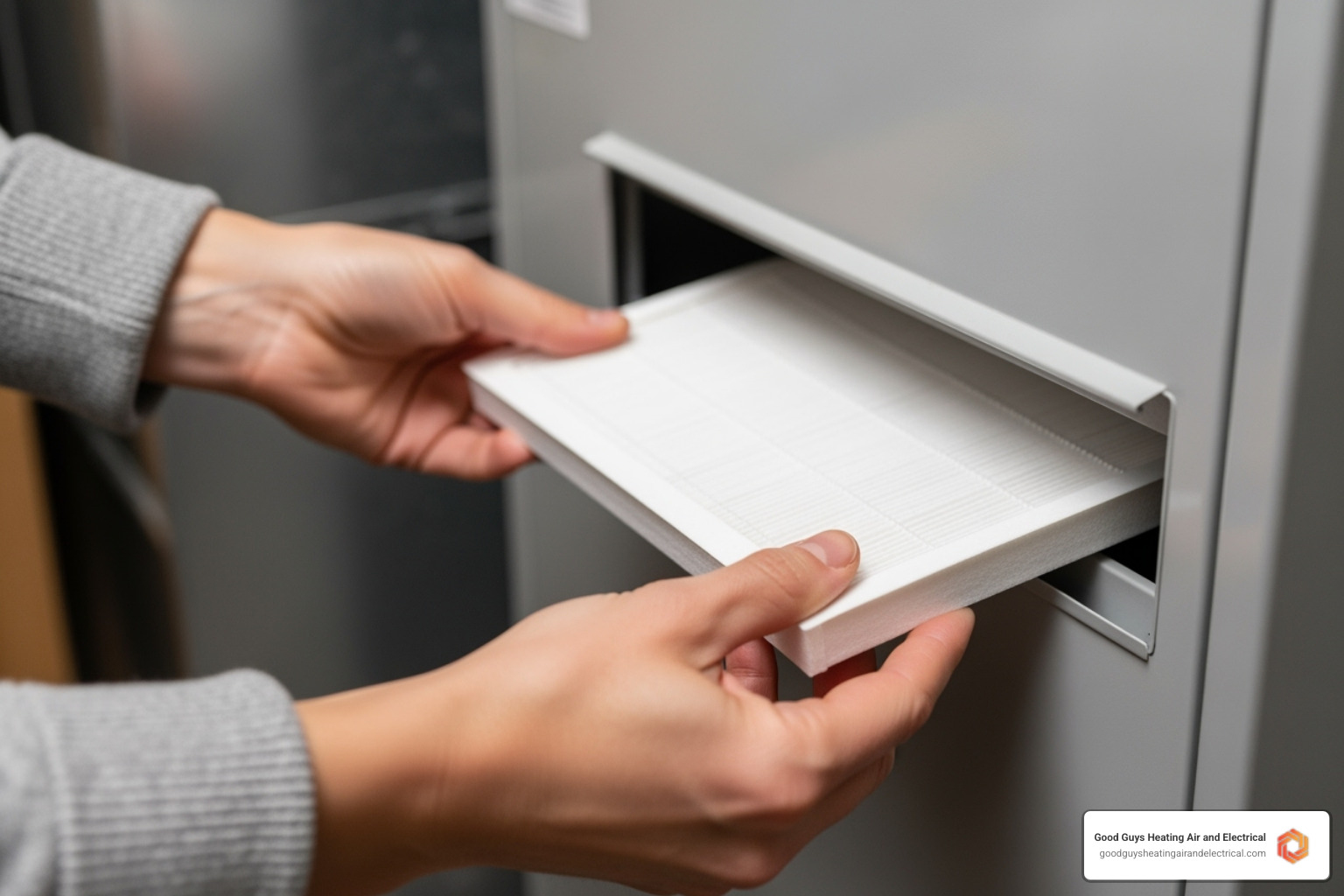
A clogged air filter is the single most common reason for AC troubleshooting Snohomish WA calls. When the filter is blocked with dust and debris, it severely restricts airflow. This forces your system to work overtime, reduces cooling performance, and can lead to frozen coils or a complete breakdown.
Checking your filter is easy. Most are located in a return air vent or inside the air handler and slide right out. Hold it up to a light; if you can't see light through it, it's time for a change. We recommend checking your filter monthly, especially during summer. If you have pets, you may need to check it more often. Replace disposable filters with a new one of the same size, or gently wash reusable filters and let them dry completely before reinstalling.
This simple habit is so critical that we include it in every AC Maintenance in Snohomish, WA visit.
Step 3: Verify Power to the Unit
Before assuming a major failure, make sure your AC is receiving electricity. Start at your home's electrical panel and look for tripped circuit breakers, which will be flipped to OFF or in a middle position. If you find one for your AC or air handler, flip it completely OFF, then firmly back to ON.
Warning: If the breaker trips again immediately, do not keep resetting it. This indicates a serious electrical problem that requires a professional. For older homes with fuses, a blown fuse will have a broken wire or blackened glass. Replace it with a fuse of the exact same amperage.
Next, check the dedicated shut-off switches. The outdoor unit shut-off switch is usually in a gray box on the wall near the condenser. Ensure it's flipped to ON. Also, find the indoor unit emergency switch, which often looks like a light switch near your furnace or air handler. It can be easily flipped off by mistake.
If all power sources are on but the unit is still dead, you may have a deeper electrical issue. Our blog on Common Electrical Issues with AC Units has more information, but it's best to call a professional for electrical problems.
Step 4: Examine the Outdoor Unit
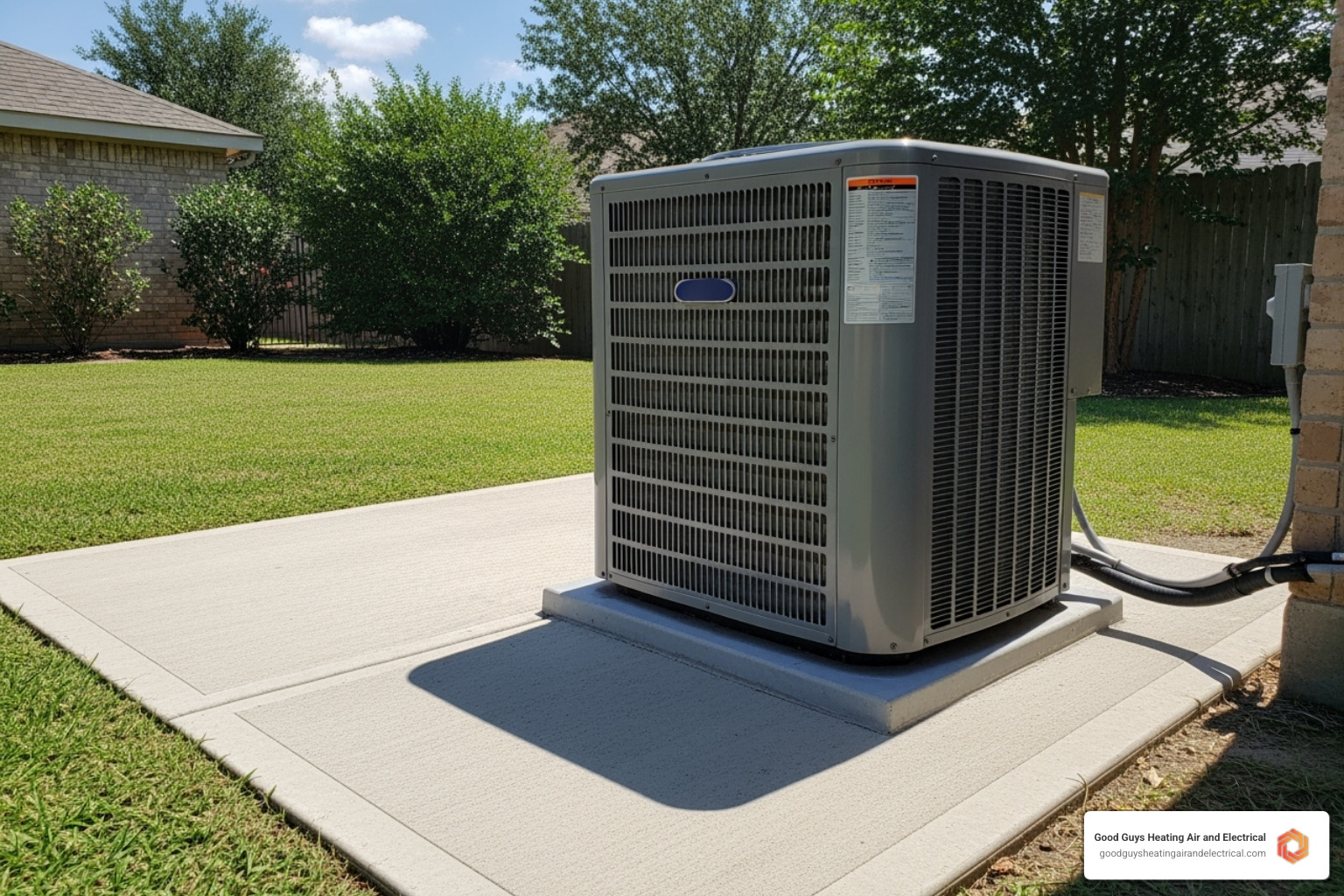
Your outdoor unit (condenser) releases heat from your home. If it's blocked or dirty, it can't do its job. Inspect the area around the unit for leaves, grass clippings, and other debris. We recommend keeping at least two feet of clear space on all sides for proper airflow.
Check the metal fins on the unit. If they are coated in dirt, they can't dissipate heat. Gently hose them down from top to bottom, but never use a pressure washer, as it can easily bend the delicate fins.
Finally, look for ice buildup on the copper refrigerant lines or the coils. Ice is never normal and usually points to restricted airflow (like a clogged filter) or a refrigerant problem. If you see ice, turn off your AC to let it thaw completely, as running it frozen can cause serious damage. If the ice returns after thawing, it's time to call us.
Common AC Problems in the Pacific Northwest Climate
Snohomish's mild climate presents unique challenges for cooling systems. Understanding these regional quirks helps you spot problems early and keep your home comfortable when heat spikes arrive.
Your AC is Running but Not Blowing Cold Air
It's frustrating to hear your AC running but feel only lukewarm air from the vents. This means the system is on but isn't completing its cooling cycle.
Weak airflow, even if the air is slightly cool, often points back to a clogged air filter or blocked vents. However, it could also signal a struggling blower motor.
If you feel warm air, the most common cause is dirty evaporator coils. These indoor coils absorb heat, but a layer of grime acts as an insulator, preventing them from working. A more serious possibility is a refrigerant leak. Refrigerant is the substance that facilitates cooling, and low levels will prevent your system from cooling effectively. Signs of a leak include a hissing sound, ice on the outdoor unit, or a gradual loss of cooling power. Refrigerant issues require a certified technician to handle safely.
Our guide on Signs AC Needs Repair in Snohomish offers more detail on these symptoms.
The System Turns On and Off Repeatedly (Short Cycling)
When your AC runs for just a few minutes, shuts off, then quickly restarts, it's called "short cycling." This pattern prevents your home from cooling properly and drives up energy bills. The constant starting and stopping also puts immense stress on the compressor, your system's most expensive component.
Common causes include:
- An oversized system: An AC that's too powerful cools the space too quickly and shuts off before dehumidifying the air.
- Low refrigerant levels: The system may run in short bursts to compensate for its inability to cool effectively.
- A clogged air filter: Restricted airflow can cause the system to overheat and shut down as a safety measure.
- Poor thermostat placement: If your thermostat is in direct sunlight or near a heat source, it will get false readings and shut the system off prematurely.
Learn more about this issue in our article on AC Short Cycles in Snohomish.
You Notice Strange Noises or Odors
Your AC should operate with a gentle hum. Any unusual sound or smell is an early warning sign that something is wrong. Addressing these alerts promptly can prevent a minor issue from becoming a major repair.
Common Warning Sounds:
- Grinding or Squealing: Often indicates worn motor bearings that need lubrication or replacement.
- Banging or Clanking: Suggests a loose or broken part, like a fan blade or compressor component. Shut the system down to prevent further damage.
- Hissing: The classic sound of a refrigerant leak. This is not a DIY fix and requires professional service.
- Continuous Clicking: Can signal a failing electrical control or relay.
Common Warning Odors:
- Musty or Moldy: Common in our humid climate, this smell points to mold or mildew on the damp evaporator coils or in ductwork, affecting air quality.
- Burning Electrical Smell: An acrid smell of hot plastic or wiring is a fire hazard. Shut off your AC at the breaker immediately and call for service.
- Rotten Eggs: Could indicate a natural gas leak if you have a gas furnace, or a dead animal in the ductwork. Turn off the system and call for help.
Our post on Why AC Creates Odors in Seattle explores these issues further. Never ignore strange sounds or smells.
When to Call a Professional for AC Repair
While DIY troubleshooting is great for simple fixes, some problems require an expert's tools, training, and safety knowledge. Knowing when to call a professional protects your system from further damage and keeps your family safe.
Warning Signs That Require an Expert for AC Troubleshooting in Snohomish, WA

If you notice any of the following red flags, stop troubleshooting and call for professional ac troubleshooting snohomish wa help.
- Electrical Smells: A burning or acrid odor is a fire hazard. Shut off power at the thermostat and circuit breaker immediately and call for help.
- Loud Mechanical Noises: Grinding, squealing, or banging sounds indicate a failing component like a motor or compressor. Continuing to run the unit can cause catastrophic failure.
- Ice Buildup: Persistent ice on coils or refrigerant lines points to a serious issue like low refrigerant or a major airflow blockage. Running a frozen system can destroy the compressor.
- Water Pooling: Puddles near your indoor unit signal a clogged condensate drain, which can lead to water damage and mold growth.
- System Fails to Start: If you've tried the basic checks (thermostat, filter, power) and it still won't turn on, the problem is internal and requires a technician.
- Blowing Warm Air: If the system runs but never cools, it likely has a refrigerant leak or compressor failure, both of which require professional service.
For these situations, our Emergency AC Repair in Snohomish, WA service is available to restore your comfort and safety quickly.
Preparing for Your Service Call
Having key information ready can make your service appointment more efficient. Before you call, try to gather the following:
- Unit Make and Model: Found on a sticker on your indoor and outdoor units.
- Age of Your System: Helps determine if repair or replacement is the better option.
- Detailed Problem Description: Note what you're seeing, hearing, or smelling, and when it started.
- Troubleshooting Steps Taken: Let us know what you've already tried, like changing the filter or resetting the breaker.
When you call for AC Service in Snohomish, WA, this information helps our technicians arrive prepared to solve the problem.
Repair vs. Replacement: Is it Time for a New AC?
Deciding between a major repair and a full replacement can be tough. We help Snohomish families weigh the options honestly.
Consider these factors:
- System Lifespan: Most AC units last 10-15 years. If your system is in or beyond this range, a major repair may not be a wise investment.
- Frequent or Costly Repairs: If you're calling for service every year, the cumulative cost may be better put toward a new, reliable system. A common rule of thumb: if the repair cost multiplied by the unit's age exceeds $5,000, replacement often makes more financial sense.
- Rising Energy Bills: Older units lose efficiency and consume more power. A new, high-efficiency model can lead to significant monthly savings.
- Benefits of New Models: Modern systems are quieter, provide better humidity control, and use environmentally friendly R-410A refrigerant. The jump in performance and efficiency can dramatically improve your home comfort.
Our job is to provide clear information so you can make the best choice for your home and budget. Explore your options in Your Complete Guide to Central Air Conditioning Systems.
The Best Defense: Preventing Breakdowns with AC Maintenance
Regular maintenance is the most effective way to prevent frustrating mid-summer breakdowns. Just like a car needs oil changes, your AC system needs professional tune-ups to run reliably and efficiently for years to come.
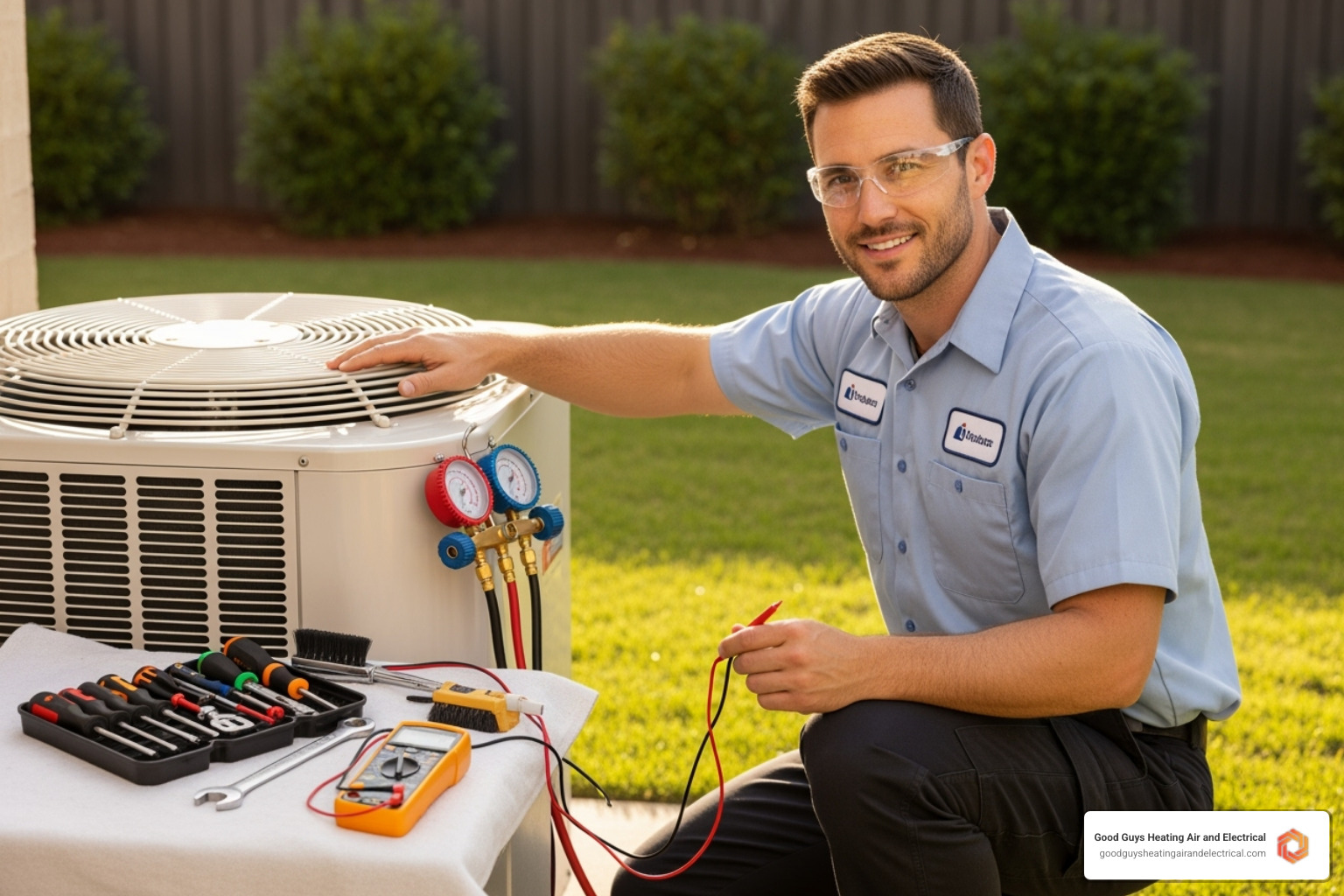
Think of maintenance as an insurance policy against emergency ac troubleshooting snohomish wa situations. During a tune-up, our certified technicians do more than change a filter; they inspect electrical connections, clean coils, lubricate parts, and check refrigerant levels to catch wear and tear before it causes a failure.
The benefits are significant. A well-maintained system runs more efficiently, lowering your monthly energy bills. It also extends your equipment's lifespan, helping you get the full 10-15 years of service out of your investment and delaying a costly replacement. Furthermore, most manufacturer warranties require proof of annual professional maintenance to remain valid.
Beyond the financial savings, regular tune-ups provide peace of mind and improve your home's health. We catch minor issues before they become emergencies and clean components where dust, pollen, and mold can accumulate, contributing to cleaner indoor air for your family.
Expertise matters. Our licensed and insured technicians are trained to service cooling systems in our Pacific Northwest climate, with many holding NATE (North American Technician Excellence) certifications—a rigorous industry standard. You can learn more at Find NATE-certified professionals.
We recommend scheduling our AC Tune-Up in Snohomish, WA service each spring to ensure your system is ready for summer. As a family-owned business, we're committed to keeping your home comfortable and safe.
Conclusion: Your Partner for a Cool and Comfortable Snohomish Home
When your AC stops working, don't panic. Many common issues can be resolved with the simple ac troubleshooting snohomish wa steps in this guide, like checking the thermostat, changing the filter, and verifying power. These quick checks can often restore your cooling in minutes.
However, it's equally important to know when to call a professional. Burning smells, loud noises, ice, or water leaks are signs that require an expert. Attempting complex repairs can be dangerous and lead to more expensive damage.
That's where Good Guys Heating Air and Electrical comes in. We are a family-owned business serving families throughout Snohomish County—from Lake Stevens and Everett to Marysville and Monroe—with honest, reliable HVAC and electrical service. Our licensed and insured technicians bring local expertise and a commitment to your family's safety and comfort.
We believe proactive maintenance is the best way to ensure reliability, lower energy bills, and extend your system's life. Whether you need an emergency repair, are considering a replacement, or want to schedule a tune-up, our team is ready to help with quality workmanship and transparent communication.
Don't let a struggling AC disrupt your comfort. Get your comfort system running right by contacting Good Guys Heating Air and Electrical today. We're here to keep Snohomish homes cool all season long.
Customer Testimonials
Service Areas


